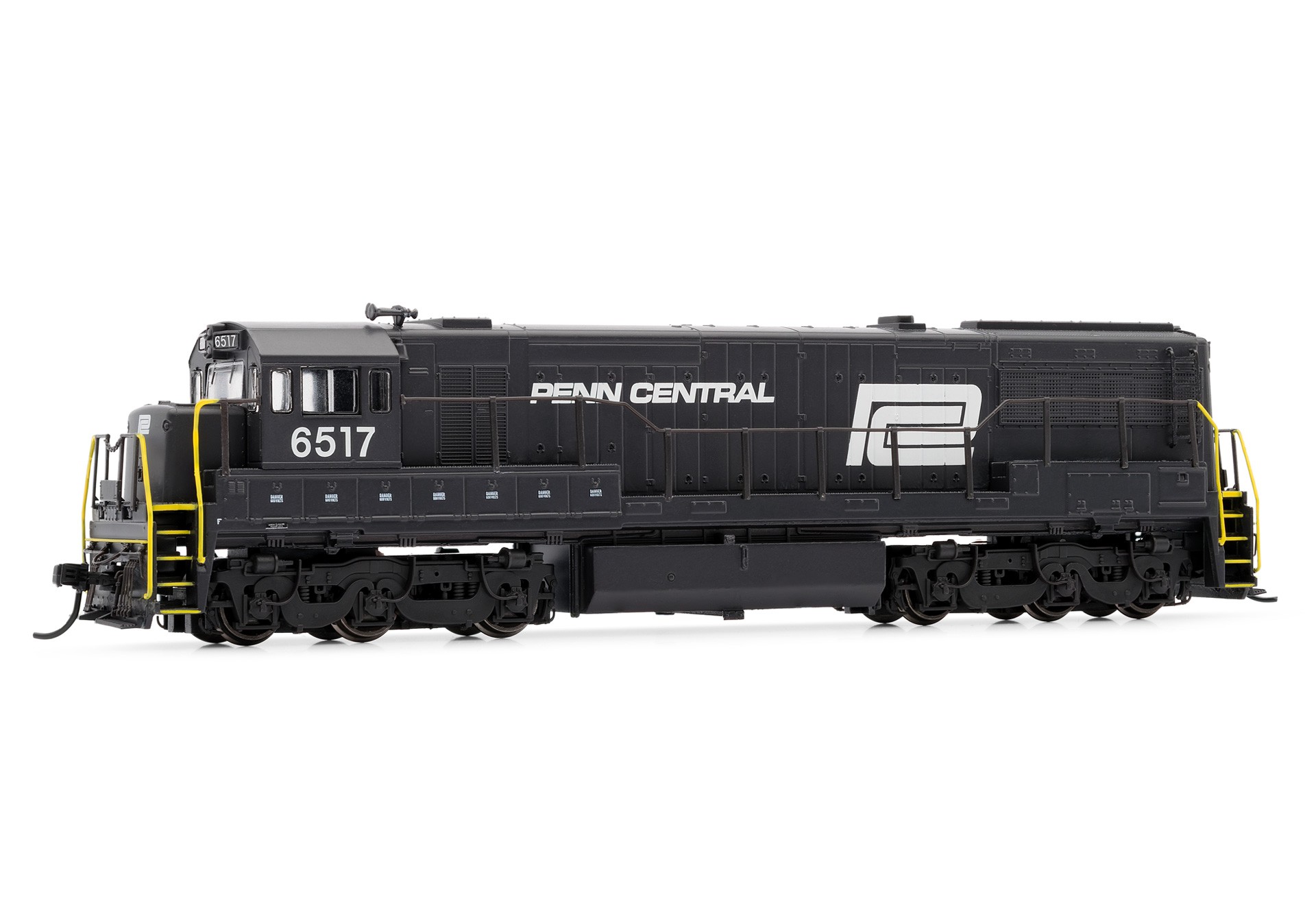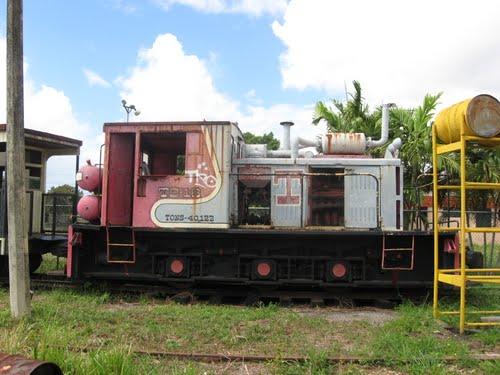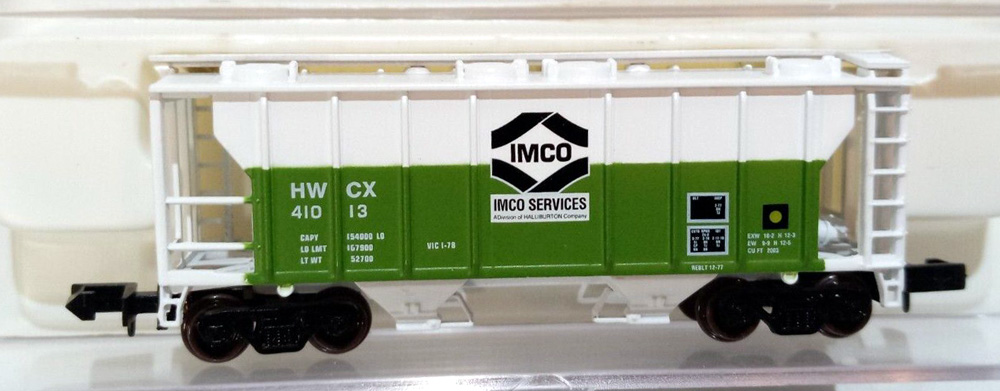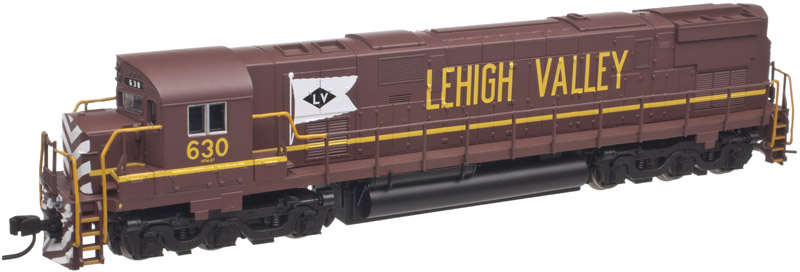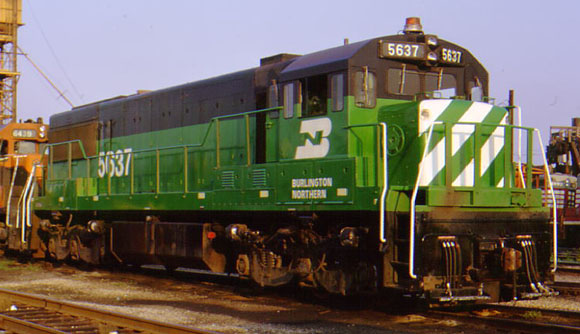Model Information: The Arnold/Hornby GE U25C was released in 2015. They later released the U28C in 2016.
This is a beautiful model with terrific paint and detailing. The lighting scheme is amazing. The model performs excellently, running smoothly and quietly at all speeds, and able to pull 40+ 40' cars without an issue. It uses a 5-pole skew-wound motor with dual flywheels. It also features a very innovative lighting scheme which is quiet cool with constant lighting of the number boards and directional lighting on the head and tail lights.
On the less positive side, as with many other N Scale 6-axle locomotives), the minimum turning radius is 11". Also, the tiny handrails are a bit fragile. To remove the shell, one must unscrew and remove the couplers (which must be handled carefully, or they may fall apart). Overall, this is an excellent model.
On the less positive side, as with many other N Scale 6-axle locomotives), the minimum turning radius is 11". Also, the tiny handrails are a bit fragile. To remove the shell, one must unscrew and remove the couplers (which must be handled carefully, or they may fall apart). Overall, this is an excellent model.
DCC Information: It is DCC Ready, configured to accept standard NMRA 6-pin (NEM 651) decoder.
Prototype History: The GE U25C was General Electric's first independent entry into the United States domestic Diesel-electric locomotive railroad market for heavy production road locomotives since 1936. From 1940 through 1953, GE participated in a design, production, and marketing consortium (Alco-GE) for diesel-electric locomotives with the American Locomotive Company. Starting in 1956 GE launched its Universal Series of diesel locomotives for the export market. The U25C was the first attempt at the domestic market since its termination of the consortium agreement with Alco.
The origin of the U25C grew out of the need for six axle locomotives to operate on a 12-mile heavy haul railroad to construct Oroville Dam. The General Electric salesman to Oro Dam Constructors offered essentially a U25B riding on six axle trucks. When the salesman got back to GE's Erie Plant it was discovered that no six axle U25 was available, nor did GE wish to construct a domestic six axle road switcher until the horsepower threshold reached 3000 horsepower. Rather than lose the four unit sale GE quickly began a design of a six axle U25 that relied heavily on the U25B for engineering. The U25C was longer than the U25B by four feet four inches. The extra length was needed to accommodate the improved Trimount trucks. Completed in September 1963 the U25C was the first six axle unit of the second generation of dieselization. Following quickly on the Oro Dam Constructor's order was an order by Atlantic Coast Line for four U25Cs. The ACL also ordered the first four Alco C628s. Both of these ACL orders were delivered in December 1963.
From Wikipedia
The origin of the U25C grew out of the need for six axle locomotives to operate on a 12-mile heavy haul railroad to construct Oroville Dam. The General Electric salesman to Oro Dam Constructors offered essentially a U25B riding on six axle trucks. When the salesman got back to GE's Erie Plant it was discovered that no six axle U25 was available, nor did GE wish to construct a domestic six axle road switcher until the horsepower threshold reached 3000 horsepower. Rather than lose the four unit sale GE quickly began a design of a six axle U25 that relied heavily on the U25B for engineering. The U25C was longer than the U25B by four feet four inches. The extra length was needed to accommodate the improved Trimount trucks. Completed in September 1963 the U25C was the first six axle unit of the second generation of dieselization. Following quickly on the Oro Dam Constructor's order was an order by Atlantic Coast Line for four U25Cs. The ACL also ordered the first four Alco C628s. Both of these ACL orders were delivered in December 1963.
From Wikipedia
Road Name History:  The Penn Central Transportation Company, commonly abbreviated to Penn Central, was an American Class I railroad headquartered in Philadelphia, Pennsylvania, that operated from 1968 until 1976. It was created by the 1968 merger of the Pennsylvania and New York Central railroads. The New York, New Haven & Hartford Railroad was added to the merger in 1969; by 1970, the company had filed for what was, at that time, the largest bankruptcy in U.S. history.
The Penn Central Transportation Company, commonly abbreviated to Penn Central, was an American Class I railroad headquartered in Philadelphia, Pennsylvania, that operated from 1968 until 1976. It was created by the 1968 merger of the Pennsylvania and New York Central railroads. The New York, New Haven & Hartford Railroad was added to the merger in 1969; by 1970, the company had filed for what was, at that time, the largest bankruptcy in U.S. history.
The Penn Central was created as a response to challenges faced by all three railroads in the late 1960s. The northeastern quarter of the United States, these railroads' service area, was the most densely populated region of the U.S. While railroads elsewhere in North America drew a high percentage of their revenues from the long-distance shipment of commodities such as coal, lumber, paper and iron ore, Northeastern railroads traditionally depended on a mix of services.
As it turned out, the merged Penn Central was little better off than its constituent roads were before. A merger implementation plan was drawn up, but not carried out. Attempts to integrate operations, personnel and equipment were not very successful, due to clashing corporate cultures, incompatible computer systems and union contracts. Track conditions deteriorated (some of these conditions were inherited from the three merged railroads) and trains had to be run at reduced speeds. This meant delayed shipments and personnel working a lot of overtime. As a result, operating costs soared. Derailments and wrecks became frequent, particularly in the midwest.
The American financial system was shocked when after only two years of operations, the Penn Central Transportation company was put into bankruptcy on June 21, 1970. It was the largest corporate bankruptcy in American history at that time. Although the Penn Central Transportation Company was put into bankruptcy, its parent Penn Central Company was able to survive.
The Penn Central continued to operate freight service under bankruptcy court protection. After private-sector reorganization efforts failed, Congress nationalized the Penn Central under the terms of the Railroad Revitalization and Regulatory Reform Act of 1976. The new law folded six northeastern railroads, the Penn Central and five smaller, failed lines, into the Consolidated Rail Corporation, commonly known as Conrail. The act took effect on April 1, 1976.
Read more on Wikipedia.

The Penn Central was created as a response to challenges faced by all three railroads in the late 1960s. The northeastern quarter of the United States, these railroads' service area, was the most densely populated region of the U.S. While railroads elsewhere in North America drew a high percentage of their revenues from the long-distance shipment of commodities such as coal, lumber, paper and iron ore, Northeastern railroads traditionally depended on a mix of services.
As it turned out, the merged Penn Central was little better off than its constituent roads were before. A merger implementation plan was drawn up, but not carried out. Attempts to integrate operations, personnel and equipment were not very successful, due to clashing corporate cultures, incompatible computer systems and union contracts. Track conditions deteriorated (some of these conditions were inherited from the three merged railroads) and trains had to be run at reduced speeds. This meant delayed shipments and personnel working a lot of overtime. As a result, operating costs soared. Derailments and wrecks became frequent, particularly in the midwest.
The American financial system was shocked when after only two years of operations, the Penn Central Transportation company was put into bankruptcy on June 21, 1970. It was the largest corporate bankruptcy in American history at that time. Although the Penn Central Transportation Company was put into bankruptcy, its parent Penn Central Company was able to survive.
The Penn Central continued to operate freight service under bankruptcy court protection. After private-sector reorganization efforts failed, Congress nationalized the Penn Central under the terms of the Railroad Revitalization and Regulatory Reform Act of 1976. The new law folded six northeastern railroads, the Penn Central and five smaller, failed lines, into the Consolidated Rail Corporation, commonly known as Conrail. The act took effect on April 1, 1976.
Read more on Wikipedia.
Brand/Importer Information: Founded in 1906 by Karl Arnold in Nürnberg, K. Arnold & Co. began its life producing tin toys and related items. They produced an extensive line of model ships, doll house items and other toys. In 1935, K. Arnold & Co. hired Max Ernst as their managing director. Ernst, not to be confused with the German realist artist of the same name, was a significant factor in the future of Arnold.
On Max Ernst's 1976 retirement, Arnold employed perhaps 200 to 250 people, using three facilities in the Nuernberg area. The Company continued under family control until 1995, when Arnold went into bankruptcy and was sold to Rivarossi of Italy. Rivarossi, in turn, also went bankrupt, leading to the sale of all assets to Hornby of the United Kingdom. Production is carried out in China.
From Wikipedia
On Max Ernst's 1976 retirement, Arnold employed perhaps 200 to 250 people, using three facilities in the Nuernberg area. The Company continued under family control until 1995, when Arnold went into bankruptcy and was sold to Rivarossi of Italy. Rivarossi, in turn, also went bankrupt, leading to the sale of all assets to Hornby of the United Kingdom. Production is carried out in China.
From Wikipedia
Item created by: George on 2016-08-23 15:07:34. Last edited by Alain LM on 2020-10-25 12:06:13
If you see errors or missing data in this entry, please feel free to log in and edit it. Anyone with a Gmail account can log in instantly.
If you see errors or missing data in this entry, please feel free to log in and edit it. Anyone with a Gmail account can log in instantly.


